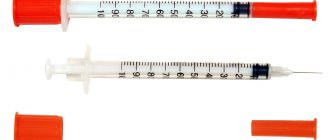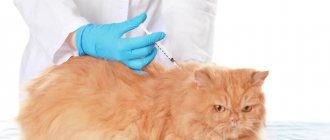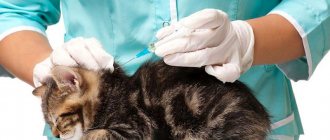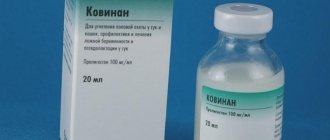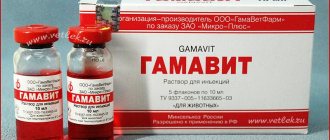For diseases, animals are often prescribed drugs in the form of subcutaneous injections. They have to be administered daily – and even several times a day. Visiting a veterinary clinic so often is inconvenient, harmful to a sick pet, and costly. If you understand how to inject a cat at the withers, you will be able to carry out all the manipulations at home. A familiar environment will reduce the animal’s stress level, and your own skills will help you save money.
General Tips
I suggest considering general tips that will help you carry out manipulations carefully and safely for your pet.
Choosing a syringe
Follow your veterinarian's recommendations regarding syringe volume and needle thickness. Insulin syringes are used for cats because their needles are thinner.
An insulin syringe will not work if:
- you need to administer a dose of more than 1 ml.
- if the substance is viscous and dense, as well as oil-based.
- if the subcutaneous fatty tissue has a high density, since a thin needle may break during insertion.
If a 2 or 3 ml syringe was selected, try not to insert the needle too deeply.
Medicine dosage
Please note that doctors sometimes prescribe one "cube" of medicine, and syringes are intended primarily for people. A syringe cube is 1 ml. For pets, one and a half doses are often prescribed, and syringes are not always marked with 0.5-2.5 ml.
I will explain using the example of a 2 ml syringe. If you need to inject 0.4 ml of medicine, this means that you should not draw 4 ml, but only fill the first four divisions of the syringe! A large dose can cause irreparable harm to the animal!
If medications are prescribed in grams, check the dosage in milliliters. If you have been prescribed NaCl 0.9% (saline), the formula for it is simple: 1 ml = 1 cube = 1 g.
How to draw up medicine correctly
Before handling, wash your hands thoroughly with soap.
First you need to open the ampoule and only after that the syringe. Point the needle into the ampoule and try not to let it touch the walls of the vessel.
Draw up the required amount of medicine.
Lift the syringe with the needle up and tap it with your fingers. Air bubbles will rise and will need to be released by pressing the plunger.
Always take a little more medicine than directed. When you release the air, some of the medicine will come out and you will get the right amount of medicine.
Sterility and safety
It is possible to treat your pet at home, but only if sterility is maintained.
- Never touch the needle with your hands, even with gloves!
- Do not reuse the syringe, even for a new dose of the next medicine.
- Do not use the same syringe for different medications, as a chemical reaction may occur.
- Up to 60 ml of the drug is injected into one point subcutaneously and up to 1 ml intramuscularly. Change injection sites if you need to inject the medicine several times a day.
- The issue of disinfecting the injection site is controversial, since the skin of cats is covered with a natural antiseptic. Check with your doctor about this detail.
- Disinfection is applicable for hairless cats.
- The injection is given only in an intact area of the body that is free of eczema, lichen, wounds and pus. Read about how to treat lichen in a cat in my other article.
Fixing the pet
It is best to carry out the procedure together, so that one can hold the cat and the other can carry out the manipulations. There are several ways to restrain cats.
Method number 1. Lying down
Grab your pet by the withers in a standing position and gently press it against a flat surface until it is in a lying position. If you are giving the injection alone, squat down and hold your pet between your thighs so that the back legs are between your legs. In this position it is easy to give a subcutaneous injection.
Method number 2. On the side
Take the pet by the withers in a standing position, with the other hand by the paws and lay it on its side. If the cat is aggressive, the second person should stand behind the pet and hold it by the limbs, pressing the body to a flat surface with the forearm.
Method number 3. In a bag or towel
A good way is to use a fixing bag, the equivalent of which can be a thick towel. You need to wrap it tightly around your pet, leaving the injection site open.
To prevent the cat from biting, a special bridle is used.
- Take a string or thick tape and thread it through a rubber tube about 10 cm long.
- Open your pet's mouth and place the bandage so that the rubber tube is in the mouth.
- Tie the lace at the back of your head.
If you carry out manipulations alone, pinch the cat's withers with a clothespin to create a feeling of false fixation.
Subcutaneous injection technique
After fixing the cat and preparing the syringe, you need to do the following:
- With two fingers, form a large fold of skin in the area of the withers or near the shoulder blade;
- gently pull it back and hold it;
- insert the needle at the base of the skin at an angle of 45° until you feel “falling into the void”, approximately half the length;
- introduce the medicine smoothly;
- remove the needle;
- straighten the skin of the withers;
- give a light massage.
When an injection is placed at the withers of a kitten, the needle must be inserted carefully and shallowly, otherwise it can get into the neck muscles. When properly injected into the subcutaneous space, the liquid will easily come out of the syringe, forming a soft ball that will dissolve in a few minutes.
An aggressive or fearful cat should receive a subcutaneous injection only after checking its veterinary passport for the presence of a rabies vaccination stamp. Because through cat bites, a person can become infected with this dangerous virus.
Preparation for the procedure
I recommend starting any stress interventions with caring attention to the animal. Most often, cats are afraid of injections and can behave aggressively, which means you must take care of your pet’s comfort. Some animals, when they see their owner with a syringe, hide. I describe how to catch a cat in another article.
Choosing a place
Choose a flat and non-slip surface for manipulation. There are different cats: some are brave and are not afraid of treatment, and some lose their courage. Therefore, make sure in advance that you have a thick towel on hand (in case of pet aggression) and a disposable diaper if the cat cannot restrain the urge to go to the toilet out of fear.
Preparing medicines
Do not prescribe the medicine yourself, administer it only as directed by your doctor. Before the procedure, double-check the dosage and order of administration of drugs (if there are several of them), because the cat’s resistance can cause confusion and confusion.
It is important to check with your doctor at what speed the drug should be administered. This is very important because it allows you to avoid shock and rapid intoxication.
Some medications must be kept in the refrigerator. Before the procedure, they should be taken out and left for one and a half to two hours to warm up to the cat’s body temperature (37-38 degrees) or to room temperature.
Prepare additional cotton wool and hydrogen peroxide to stop the bleeding if something goes wrong. Provide convenient and quick access to them.
Step-by-step instruction
There are three types of injections: subcutaneous, intramuscular and intravenous. Injecting medicine into a vein is difficult; specialists do this, so we will only consider the first two types.
Subcutaneous injection
Subcutaneous injections are made into the withers (between the shoulder blades) or into the knee fold. Most often, injections are prescribed at the withers, because it is less painful and there is a lower risk of hurting nerves and blood vessels.
- Place your pet on a flat surface. Give it time to calm down.
- Grasp the cat by the fur, having previously secured the animal, and slightly pull part of the skin. A fold should form.
- While the second person firmly holds the pet's body, insert the needle into the resulting fold. The insertion angle is 45 degrees. Place the needle 1-1.5 cm deep.
- At first you will feel resistance, the needle will enter tightly. As soon as you feel that the resistance has disappeared, it means that you have entered the skin.
- Administer the medicine as directed. Pull out the syringe and release the skin.
- Massage the injection site with your thumb and give your pet a treat.
Intramuscular injection
When giving an intramuscular injection, the most important thing is to choose the right puncture site. Usually they prick in the hind leg, in the middle third of the thigh along its posterior-outer surface. The depth of needle insertion is 1-1.5 cm.
Feel the area above the cat's knee (middle third of the thigh). There you will find a hole in which it is best to inject.
- Secure the cat on a flat surface and massage the injection site. To do this, bend your pet's paw and relax it with a massage.
- Feel the bone and step back from it one and a half to two fingers so that the insertion falls on the posterior outer surface of the thigh. This will indicate the approximate injection site.
- Insert the needle at a 45 degree angle.
- Pull the plunger back slightly. If blood appears, it means you have entered a blood vessel. There is nothing wrong, take out the syringe and insert the needle into another place.
- If there is no blood, administer the medicine. On average, the drug should be administered in 2-3 seconds.
- Pull the needle out and massage the injection site. Give your pet a treat.
Which syringe to use for injection
Injection is the administration of liquid medications using a syringe subcutaneously, intramuscularly, or intravenously. There are two more types of injections: intraosseous and intraperitoneal. But these manipulations can only be done by a specialist in a clinical setting. And intravenous injection is difficult to carry out independently. Owners can easily learn how to do subcutaneous and intramuscular injections themselves.
The syringe for injection should be selected in accordance with the prescribed drug and its quantity required for administration. For small doses, within 1 ml, you should choose an insulin syringe. It has a thin needle, and measuring the drug in a dose of less than 1 ml is much easier thanks to a more convenient scale. In all other cases, a syringe of 2 ml is used.
The insulin syringe has a thin needle and a convenient measuring scale
Side effects
Sometimes complications may arise after the procedure, which frighten the owners. But not all of them are scary!
- If blood appears after the injection, stop it with peroxide. If bleeding continues for more than 20 minutes, call your doctor.
- The appearance of lumps or abscesses is an indication for urgent surgery.
- Lameness for 2-3 days is normal. But if the cat drags its paw, this may indicate damage to the sciatic nerve. Show it to your doctor immediately.
- A high temperature is an indication to consult a veterinarian to rule out the possibility of infection during the injection.
Possible complications
As a rule, injections do not cause negative consequences. But sometimes they can arise not only from an inexperienced owner, but also from a specialist. It is important to know about possible complications in order to provide your pet with the necessary help in a timely manner.
If you inject your cat incorrectly, for example, by injecting the drug into the wrong place, damaging a blood vessel, or hitting a nerve, problems may include the following:
- If at the injection site after removing the needle drops of blood appeared
, then this indicates damage to the wall of the blood vessel. If a few drops of blood are released, then to stop the bleeding it is enough to apply cold to the injection site for 10-15 minutes (ice or a frozen product from the freezer, wrapped in a clean cloth or a damp, cold towel).
- Infiltration or compaction
(bump, swelling) at the injection site indicates that the injected medicine is not absorbed into the bloodstream, or an inflammatory process has begun in the injured tissue or surrounding tissues. The causes of infiltration may be: the introduction of too much of the drug at once, infection along with it, very rapid administration of the drug, an allergic reaction of tissues, the use of drugs without prior warming to body temperature. What to do in such a situation? If the infiltrate does not resolve, does not go away for a long time, the area of compaction becomes hot, painful, increases in size, the animal’s well-being worsens, it is necessary to show the cat to a veterinarian.
- Long-term non-absorbable infiltrates and compactions can lead to the occurrence of abscesses
. A purulent inflammation forms in the infiltrate cavity or at the site of compaction; the injection site may swell, become hot and painful. The cat may refuse to eat, become lethargic, apathetic, and its body temperature will rise. This condition is dangerous and in severe cases can lead to sepsis and death of the animal. It is important to seek surgical help as soon as possible.
- Lameness after injection
. There can be several causes of lameness. One of them is muscle damage due to the use of tissue irritating solutions, antibiotics and thick, difficult to dissolve drugs, leading to severe pain at the injection site. Lameness can occur as a result of an unsuccessful injection, or as a result of a needle getting into a nerve. As a rule, lameness goes away within an hour after the injection. If the lameness intensifies and does not go away within several days, the limb has lost mobility and cannot straighten, and the cat does not lean on it when walking, it is necessary to show your pet to a doctor.
- Temperature increase.
This reaction of the body can be caused by an allergy to the injected drug, or serve as a symptom of an inflammatory process at the injection site. This can happen if sterility was not maintained during the procedure.
- Severe reaction to stress
. Cats are very sensitive animals. They have a hard time enduring long-term chronic stress, pain and discomfort. If the pet takes the injections too hard, hides after the procedures, becomes fearful and nervous, refuses to eat, does not allow itself to be touched, hides in secluded places and does not come out of them for a long time, then, in agreement with the attending physician, it is advisable to switch as soon as possible. for other forms of drug administration. For example, for tablets or suspensions. To reduce stress levels, you can use special calming synthetic facial cat pheromones in the form of a diffuser.
Pay close attention to your pet's well-being and changes in behavior. If there is refusal to eat, lethargy, fever, pain at the injection site, or bloody or purulent discharge at the injection site, immediately take your pet to a veterinarian.
The following video discusses how to properly inject a cat intramuscularly.
